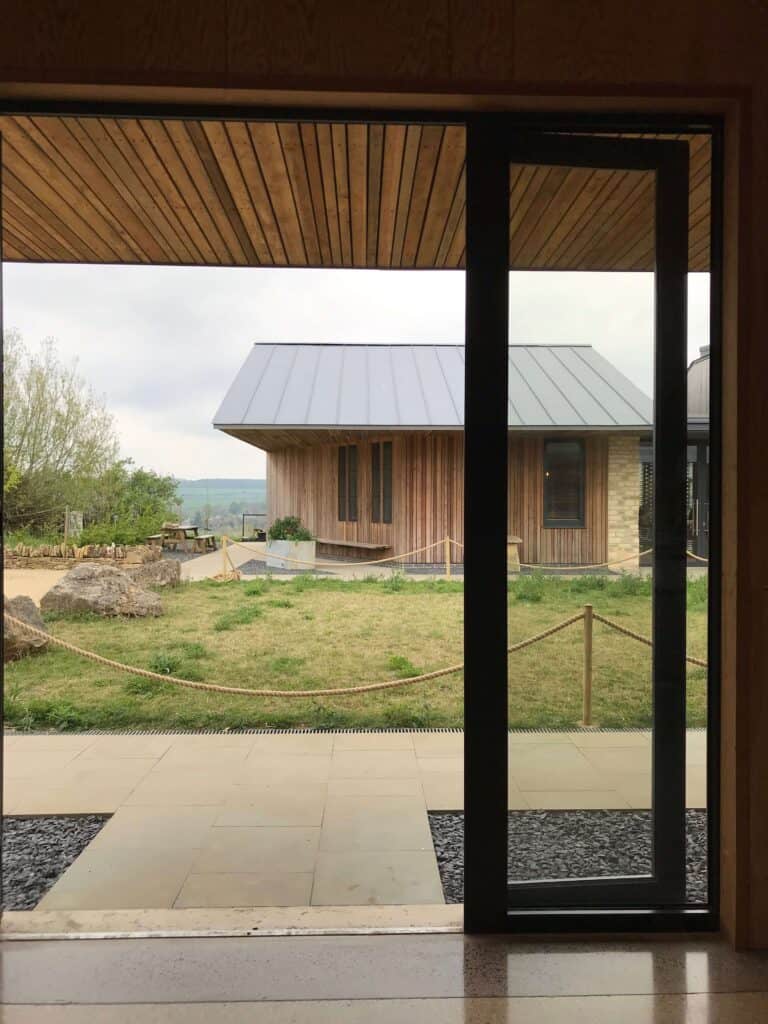I had the pleasure of attending a talk and lunch at FarmED in Oxfordshire recently. Its purpose is to educate about sustainable farming. This includes not only restorative farming practices but also supporting local micro-businesses. The buildings are designed by Timothy Tasker Architects and to Passivhaus standard. The design clearly opted for a thermal wrap around the structure, as shown by the exposed steel portal frames internally. This lends the interior an industrial aesthetic in keeping with the farming purpose. The buildings are barn-like forms arranged around a ‘yard’ (actually a lovely wild lawn) which maximises views of the valley beyond. It suits the setting beautifully. The cafe has a fabulous circular bar around a central pizza oven. I was reminded of Mapuche Ruka with a large central open fire and seating around it – very atmospheric. I liked the roof overhangs which reduce overheating from summer sun, but let the winter sun in. Below are a few things I learnt during the talk.
The problem with intensive farming
Ian Wilkinson, founder of FarmED gave an inspiring talk about the problems with farming today and how they are working on solutions. Personally, I have also enjoyed Jeremy Clarkson’s farming show, which has done a great job of highlighting many of the issues facing farmers today – including high price of fertilisers (higher still following the energy crisis). Climate change causing flooding, ruining crops or even the opportunity to sow them. Delays in architecture and construction are frustrating, but farmers have it a lot worse. The fact that Clarkson, not known for his environmentalism, is speaking out in favour of restorative farming, wildflowers and grasslands says something about the situation we are in.
During the war the pressure was on to produce as much food as possible from the land and this continued post-war with farming subsidies supporting intensive agriculture. But decades of fertilisers, mono-culture, pesticides and herbicides have left us with very poor soil. Our vegetables contain less nutrients today than they did in the 50s because the soil they grow in has been eroded.
Restorative Farming – how it works
I grow vegetables on an allotment. I rotate my crops so that, for example, nitrogen from the beans can help to fuel the broccoli that follows. I add farm manure each year, that worms digest and break down to feed the soil. Smaller farms used to do the same – rotate arable crops with grazing animals and allow fallow periods where the soil would recover and wildflowers could grow. As farming became more intense, smaller farms were swallowed up by the larger estates – unable to compete with them. 200 acres used to be a good sized farm. Nowadays it’s hard to make any money at all on less than 1000 acres. Many farms in the UK are multiples of that. This makes it very difficult for farmers, fresh out of agricultural college to get going. Unless you inherit a farm (which doesn’t account for many) there are few options. But we need the smaller farms, the diversity. Just like with house-building, smaller scale usually means better quality. It’s better for local economies and better for the environment too.
The solution or part of it
FarmED are helping to change this by allowing micro businesses to rent just 5 acres. The results are initially very promising. One micro business can earn £65k from their 5 acres. It isn’t a huge income, but it supports a family and they have a life they enjoy. It is certainly better than the £11k earned from 100 acres of barley, which cost £11k to produce. This latter kind of agriculture is not only bad for the environment (it’s a mono-culture, which doesn’t support insects and is heavily fertilised which ends up in our rivers) but is wholly reliant on subsidies to pay the farmer anything at all. This is far from sustainable. In addition, farmers are taking huge risks each year betting on a single crop, investing in fertilisers, diesel and seed, when it could all go horribly wrong with one bout of bad weather. Micro businesses regenerate the soil with a variety of crops and livestock and therefore take fewer risks.
So what can non-farmers do to help?
We can support these micro businesses and buy local produce. This also means farmers get more for their produce, because the money is going directly to them instead of via a supermarket or other facilitator. One of the schemes at FarmED – the Kitchen Garden People – is a CSA or Community Supported Agriculture, common in the US, not so much in the UK. It’s where communities support farming businesses and risks are shared (read more on the previous link). We can increase biodiversity in our gardens by planting wildflowers, creating habitats and generally making our gardens nicer for us and for wildlife.

